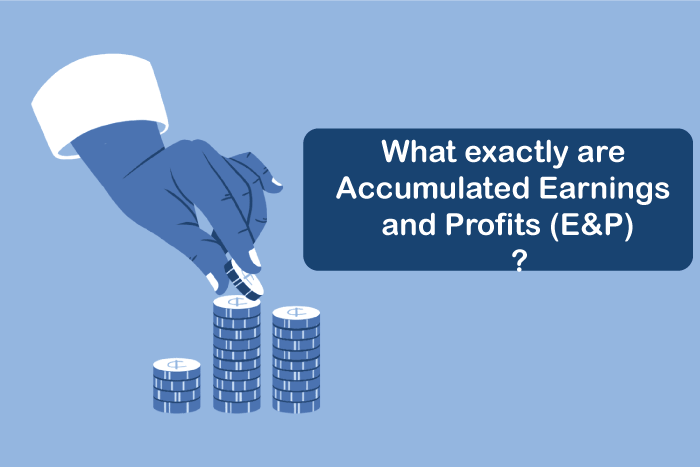Accumulated Earnings and ProfitsOverview of Accumulated Earnings and Profits (E&P)It is simply a corporate accounting term. Accumulated earnings and profits refer to a company's net profits left after paying dividends to investors. Accumulated E&P help gauge a company's financial ability to pay certain cash payments. 
How does it work?End-of-year accumulative earnings and profits refer to the addition of beginning-of-year E&P with the current period E&P and the deduction of distribution payments made to shareholders within the same period. Revenue and losses are both included in a period's E&P. However, some items, especially those recognized for financial accounting but not for income tax reporting, are subject to changes or modifications. Because E&P is utilized to gauge a company's ability to make distributions, tax-exempt revenue and nondeductible costs that affect income tax reporting must be re-added or deducted from the E&P account. Calculating E&P each year is time-consuming for tax departments inside a corporation. Still, it is critical to maintain current records since they are used in many corporate transactions. Before converting any XYZ business to a real estate investment trust (REIT), for example, a comprehensive accounting assessment of accumulated E&P is required. How to calculate Earnings and Profits (E&P)?First of all, it is to be noted that the end-of-year cumulative earnings and profits are typically the sums of the beginning year's E&P. Therefore, the accumulated earnings are nothing but retained earnings by any company after paying dividends. In financial reports, these earnings are typically recorded in the equity section of the shareholder in the corresponding company. The following is the formula to calculate the retained earnings (RE): RE = Initial RE + Net Income Dividends Let us now understand the concept with an example. Suppose a company named ABC has accumulated earnings of about $100,000 at the start of the year. The company distributes dividends worth $300,000 and makes around $700,000 in net profits in the same year. In that case, we can calculate the company's retained earnings as below: RE = ($100,000 + $700,000) - $300,000 RE = $500,000 This remaining income (or retained earnings) will then be recorded in the financial report under the accumulated income item at the end of the year and will be used to finance any future operations and facilitate expansion. Calculating E&P each year takes time for a corporation's tax department. Nonetheless, keeping records up to date is vital since they are used in many corporate activities. What is the value of Accumulated Earnings & Profits?Accumulated profits are a company's cash-held earnings. Dividends are paid to shareholders in exchange for this cash. The amount of dividend is determined by the proportion of shares an individual owns in their portfolio. This information is available or recorded in the company's balance sheet annually. Accumulated earning is often referred to as retained income or undistributed revenue. If some earnings remain in the company accounts after the dividend, they can be reinvested or saved for future business development and opportunities. What are the working criteria for Accumulated Earnings and Profits (E&P)?Individuals frequently make errors in conceptions while calculating annual incomes and profits. At the end of the year, the accumulated earnings and profits are again treated as the total of the earnings and profits at the start of the new fiscal year and called the current earnings and profits. The ratio of shareholder distribution is mostly subtracted in this computation. Income and loss are calculated using particular items and data, omitting the income tax ratio from the total accumulated earnings and profits (E&P). Accumulated E&P indicates an industry's or firm's capacity to pay for certain instruments, especially those to be distributed, specified nondeductible expenses, and standard income tax ratio. What are some points to consider?Most firms, businesses, and corporations require managing E&P accounts to establish the appropriate tax treatment. Although they are not required to report E&P, they must know the amount to determine the tax status of a transaction. Maintaining the accumulated E&P balance for continuous periods is considerably easier than preparing the computation after several years at once. The tax regulations do not specify how to compute E&P, and the procedure to create and maintain E&P is typical. Generally, the E&P for any year begins with the year's adjusted taxable income. It is to be noted that almost every transaction somewhat impacts a company's E&P. Additionally, specific actions (such as mergers) may also significantly affect E&P. Other forms of revenue, such as tax-exempt income and installment sales, can supplement E&P. Cash costs that are paid but may not be taxed, such as charitable contributions and capital loss carryforwards, reduce E&P. Accumulated E&P Vs. Retained EarningsWhile they may appear synonymous, they are differences between them. E&P is a determinant of a corporation's capacity to fund payouts. A business can lower the amount of its retained profits by stock distributions or the establishment of a contingency reserve, but this will have no impact on the company's capacity to pay dividends to shareholders. The Bottom LineAccumulated E&P is the fundamental notion of determining the profit and earnings ratio of the company after all dividend distributions have been made to shareholders. This computation considers various factors such as tax payments, acquisition and merger, market circumstances, and so on. Generally, the retained earnings in the firm's account are used to calculate accumulated E&P. It is critical for any company since it may be employed in growth plans and expansion.
Next TopicAccumulated Fund
|
 For Videos Join Our Youtube Channel: Join Now
For Videos Join Our Youtube Channel: Join Now
Feedback
- Send your Feedback to [email protected]
Help Others, Please Share









